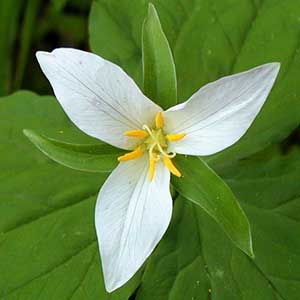Trillium ovatum
Trillium recurvatum
Pacific trillium, trillium, western trillium, western wake-robin, western white trillium, white or western trillium, white trillium
bloody butcher, bloody noses, prairie trillium, prairie wakerobin, toadshade
semierect to horizontal, short, stout, praemorse.
horizontal, white, slender, elongated, brittle.
1–2, round, 2–5 dm, ± slender, glabrous.
typically 1(–3), round in cross section, 1.5–4.8 dm, slender to robust, glabrous.
sessile, subsessile, or short-petiolate;
blade medium green, sometimes blotched and mottled, main veins prominent, ovate-rhombic, 7–12 × 5–20 cm, continuing to expand during anthesis, base rounded, apex acuminate.
held well above ground, strongly petiolate;
blade at first strongly mottled in darker green or bronze, mottling fading with seasonal expansion after anthesis, rarely all green, ovate, elliptic, or lanceolate, 6–18 × 2.5–6.5 cm, not glossy, apex acuminate;
petiole ca. 1/5 bract length.
erect or nodding, odorless;
sepals spreading to horizontal, green, lanceolate to oblong-lanceolate, 15–50 × 6–20 mm, margins entire, apex acute;
petals erect-ascending, usually wide-spreading from base, exposing entire pistil, white or with pink or blush markings, lacking V-shaped markings, fading to rosy pink, purple, or dark red, veins not deeply engraved, ± linear to widely obovate, 1.5–7 ×1–4 cm, widest at or above middle, thin-textured, margins flat to undulate, apex acuminate;
stamens prominent, slightly recurved-spreading to straight, 10–18 mm;
filaments white, shorter than anthers, slender;
anthers yellow, 4–16 mm, slender, dehiscence latrorse-introrse;
ovary green or white, ovoid, 6-angled, 5–12 mm, attachment ± 3/4 ovary width;
stigmas recurved, barely connate basally, greenish white or white, linear, not lobed adaxially, 6–10 mm, uniformly thin;
pedicel erect to leaning, 2–6 cm.
erect, fragrance not reported;
sepals strongly recurved basally and held against scape by turgor pressure, green, sometimes purple-streaked, ovate-lanceolate, 18–35 × 6–18 mm, margins entire, apex acute;
petals long-lasting, erect, ± connivent, ± concealing stamens and ovary, dark maroon purple to clear yellow, occasionally 2-colored with purple and yellow, not spirally twisted, lanceolate to ovate, 1.8–4.8 × 0.9–2 cm, thick-textured, base attenuate to weakly clawed, margins entire, apex acute;
stamens incurved, 10–15 mm;
filaments erect, dark purple, 4–6 mm, ± slender;
anthers strongly incurved above filaments, dark purple, 5–16 mm, ± thick, dehiscence introrse;
connectives strongly incurved inward, dark purple, projecting about 1 mm beyond anther sacs;
ovary greenish with ± purple stains distally, transversely rhombic to angular-ovate, somewhat 6-angled or -winged, 7–10 mm, ± equaling filament height;
stigmas erect, divergent-recurved, distinct, ± linear, 4–6 mm, slightly thickened basally.
baccate, green or white, ± odorless, broadly ovoid, obscurely winged, 1.2–2.8 × 0.7–1.9 cm, pulpy-moist.
green to white- and purple-streaked, odorless, rhomboid-ovoid, 6-angled, almost winged, ca. 1 cm diam., pulpy.
= 10.
= 10.
Trillium ovatum
Trillium recurvatum
Varieties 2 (2 in the flora).
(Discussion copyrighted by Flora of North America; reprinted with permission.)
Trillium recurvatum has several named color forms, most notably forma shayi E. J. Palmer & Steyermark with clear yellow petals, and one foliose anomaly (possibly caused by mycoplasma).
(Discussion copyrighted by Flora of North America; reprinted with permission.)
1. Bracts sessile; petals lanceolate to obovate, 1.5–7 × 1–4 cm | var. ovatum |
1. Bracts distinctly short-petiolate; petals linear to linear-lanceolate, 0.5–2.4 × 0.2–0.6 cm | var. oettingeri |
- Local floras:
BC,
CA,
OR,
WA
- Local Web sites:
CalFlora,
CalPhotos,
Flora NW,
PNW Herbaria,
Turner Photog.
WildflowerSearch
iNaturalist (observations)
USDA Plants Database
- LBJ Wildflower Center
- SEINet
- Plants of the World Online
- Encyclopedia of Life
- Wikipedia
- Google Image Search


